Intel Unveils Moorestown and the Atom Z600, The Fastest Smartphone Platform?
by Anand Lal Shimpi on May 4, 2010 11:54 PM EST- Posted in
- Smartphones
- Intel
- Atom
- Mobile
- SoCs
CPU Performance: Moorestown Rocks?
In my iPad review I pointed out the huge gap between the performance of today’s 1GHz smartphone SoCs and an Atom powered netbook.
It’s impossible to estimate the performance of Moorestown without functional hardware, but we can assume that it’s somewhere in between the ARM based SoCs and the netbook in the chart below.
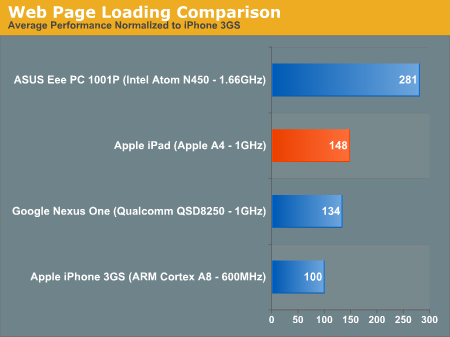
Intel provided some SPECint numbers comparing Moorestown to various smartphone application processors shipping in 2010 (either now or later). Keep in mind that SPECint is just as much of a compiler benchmark as it is a hardware benchmark, so real world performance could very well differ. We won’t know how well Moorestown stacks up until we can evaluate it ourselves. But if Intel’s numbers are even remotely accurate, this is the sort of leap in performance we honestly need in the smartphone space:
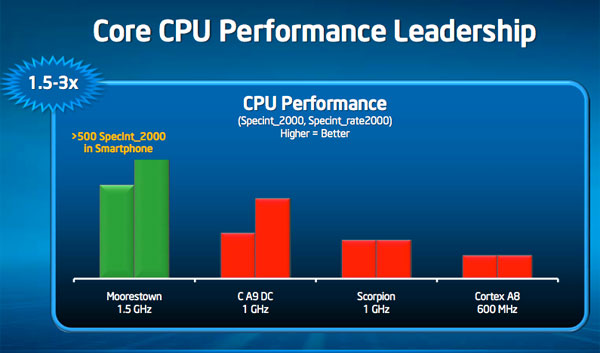
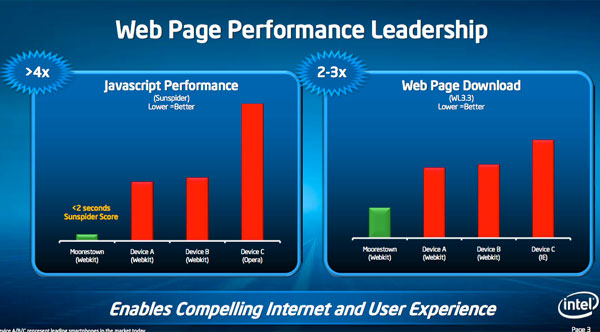
The slowest member of the Atom Z600 series will run at 1.2GHz, the fastest (for smartphones) will run at 1.5GHz. While multithreaded performance on a dual Cortex A9 at 1GHz approaches that of a 1.2GHz Moorestown, nothing can touch the 1.5GHz part. Single threaded performance is just as impressive.
The Sunspider score is super impressive as well. Intel is posting a sub-2s Sunspider score, the best we've seen thus far on a ARM based platform is ~10 seconds on the iPad:
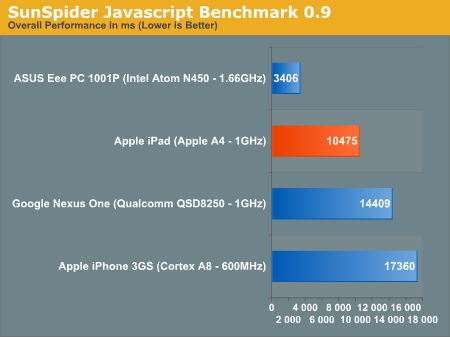
These numbers are from Intel so we have to take them with a grain of salt. And as I already mentioned, we’re looking at pure CPU/compiler performance here - real world application performance is a different story entirely. But it’s a safe bet to assume that Moorestown will at least be faster than any application processor on the market today.
A high clocked dual Cortex A9 could give it a healthy challenge though.
GPU Performance: Moorestown Rules?
Intel provided three numbers to instill confidence in Moorestown’s graphics capabilities. The first was a claim of over 100 fps running Quake 3. I saw this in person so I can confirm that you can actually run a timedemo of Quake 3 at above 100 fps on Moorestown. NVIDIA claims over 40 fps on the Tegra 2 at 720p with AA, but it’s unclear how comparable these numbers are.
The next two numbers are from 3DMark Mobile ES 2.0 using the Taiji and Hoverjet benchmarks:
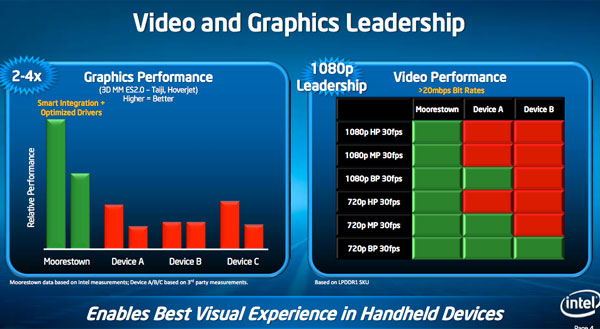
This is comparing the performance of Moorestown to the lower clocked SGX 535 among other GPUs. The performance improvement is more than 2x.
Again, these came from Intel directly so we can’t vouch for their applicability to the real world.










67 Comments
View All Comments
Mike1111 - Wednesday, May 5, 2010 - link
IMHO Anand meant app-centric smartphones, David Pogue calls them app phones.jasperjones - Wednesday, May 5, 2010 - link
i don't see how recent symbian devices are not "app centric." you have the publicly available sdk, the ovi store, etc.BrooksT - Wednesday, May 5, 2010 - link
So your argument is that symbian is a bigger player in the app phone market than Apple because their *latest* phones support apps?The "smartphone" / "app phone" semantic difference is annoying, but if we look at, say, number of applications available or downloaded, Symbian and RIM are distant third and fourth places. Likewise with app usage, even just internet browsing.
If you want to talk about smartphones as they existed in 2006, then yes, both Symbian and RIM are much bigger than Apple or Android.
jasperjones - Wednesday, May 5, 2010 - link
To clarify: I said "recent" because the first Symbian smartphones came out almost 10 years ago--of course, those weren't app-centric.My original comment on Anand's article still stands. I'm talking about IDC's and Canalys' reports on 2010:Q1 smartphone sales which became available just days ago. Of course, most of the smartphones sold by Nokia and RIM in the first quarter allow for installation of apps such as Facebook, Ovi Maps, etc., etc.
WaltFrench - Sunday, May 9, 2010 - link
“…Apple and Google dominate the smartphone market. This is utter nonsense.”All you have to do is to look at the developer space. How many app developers are creating apps for the unreleased RIM OS 6? … for the Symbian OS^3, due out in “select” markets sometime in Q3?
If older apps work OK in these new OS incarnations, and if Blackberry and Nokia users are heavy app downloaders (or for some reason will become heavy users), then the current sales-share leaders are relevant, but still not dominant, in the future of app phones.
nafhan - Wednesday, May 5, 2010 - link
I'm curious about the PCI bus requirement for Windows 7 that would prevent it from running on Moorestown devices. Does it have something to do with storage, maybe? I'm having trouble finding specifics online as well. If someone could enlighten me, it would be appreciated.DanNeely - Wednesday, May 5, 2010 - link
This is almost certainly a factor of windows being a monolithic kernel and MS not having any way to say "this PC doesn't do PCI". This is something that MS will have to deal with in the medium term future anyway. PCI slots are going away from some high end mobos; it's only a matter of time before they disappear from mainstream boards and stop being used to attach misc controllers like PATA (slowly going away entirely) or FireWire (FW3200 will need PCIe bandwidth). At that point intel will want to take it out of their chipsets as a cost saving feature, and oems will not be happy if they have to install a PCIe to PCI bridge to maintain windows compatibility.Drizzt321 - Wednesday, May 5, 2010 - link
Maybe HP/Palm should get with Intel and optimize WebOS for this. Much of the WebOS stack is just Linux, Webkit, plus other F/OSS stuff like gstreamer and the like so I wouldn't be surprised if it isn't as big an effort as, say, Symbian or anything like that.This could be a big break for Intel and HP/Palm, since HP/Palm needs something big to help it move on to the next WebOS device, and the OS could certainly see some benefits to more CPU power. I've heard the overclocking patches raising the CPU to 800MHz can really help things.
sleepeeg3 - Wednesday, May 5, 2010 - link
Please stop designing faster phones.Phone A lasts 24 hours standby
Phone B lasts 6 hours standby
After 6 hours, Phone B's battery is dead. How much use do you get out of a phone with a dead battery? 0.
999GHz x 0 is still... 0!
This push toward faster phones, without even considering battery life, is nuts. Phones are impractical tools for just about everything, but calling, messaging and photographs. None of these are CPU intensive. Dependability is more important than how fast the dial screen opens.
Moorestown may include better power architecture, but it throws this away by jacking up the processor speed.
Lets get back to practicality and make phones functional again. This push toward cutesy 1000mAH/1GHz+ phones that die in a few hours is moronic.
Is it too much to ask for phones that last a week?
metafor - Thursday, May 6, 2010 - link
There are plenty of phones that last a week...They even cost significantly less than GHz smartphones and usually don't come with a 2-year contract.
But they don't have giant 4.2" AMOLED screens (which btw, is ~50% of the power consumption) either.